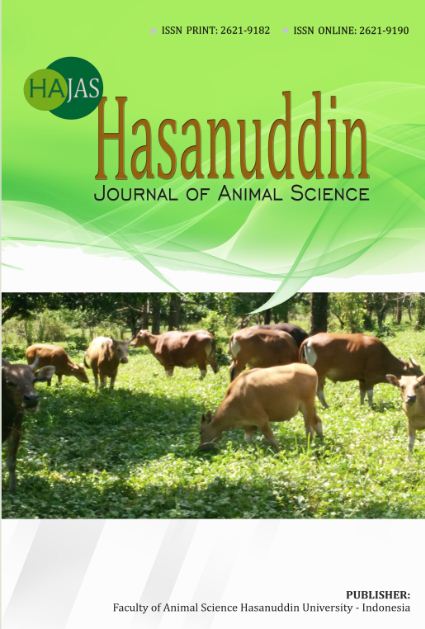The Reproductive Performance of Bali Cows through Artificial Insemination Program in Polewali Mandar Regency, West Sulawesi Province
Abstract
Intensification of artificial insemination (AI) in Bali cattle is a government program to increase the population and productivity of local cattle. The objective of this study was to examine the reproductive performance of Bali cows through the AI program in Polewali Mandar Regency, West Sulawesi. The study was conducted in two different locations, i.e. in the low lands (<300mASL) including Wonomulyo and Campalagian Districs, and high lands (>300mASL) including Limboro and Bulo Districts. Data collection was carried out on farmers and inseminators profiles, and cow’s reproductive parameters including service per conception (S/C), conception rate (CR), calving rate (CvR), calving interval (CI) and Calf Mortality (CM). These data were calculated and analyzed descriptively. The cows in this study were raised by farmers in small-scale farm, mostly under 5 heads. The cattle breeding through AI program was carried out by inseminators with over 10 years of experience. In the lowlands, S/C values were 1.26-1.17 and CI were 360 to 366.31 days, respectively. Bali cows that were inseminated using Bali bull semen had a CvR of 75.69% which were higher than those using Simmental bull semen (CvR 49.69%;). While in the highlands, Bali cows that were inseminated with Bali bull semen tended to have higher S/C (1.30) and CI (356.95 days) values but had CvR of 61.00% and CR 77.00% which was also higher than that of Simmental bull semen (S/C 1,50; CI 412,86 days; CvR 50.00%; CR 66.67%). The high S/C in the highlands (1.50) is due to location constraints or the distance between the livestock and the inseminator's residence which is quite far, so it takes time to carry out AI services and is one of the factors that can cause the provision of AI services for female cows in heat is not optimal. In the highlands, most of the cattle are grazed in the grazing areas, making it difficult for breeders to detect estrus. In general, Bali cattle produced by AI in the low lands of Polewali Mandar district tended to have better reproductive performance than those in the high lands. The S/C in the low lands (1.26 and 1.17) is lower than that in the high lands (1.3 and 1.5).
Keywords: AI, Bali cows, lower land, high land reproductive performance
Downloads
Published
Issue
Section
License

This work is licensed under a Creative Commons Attribution-NonCommercial 4.0 International License.










